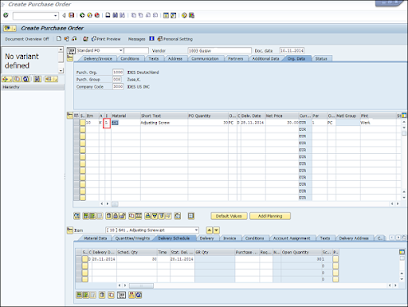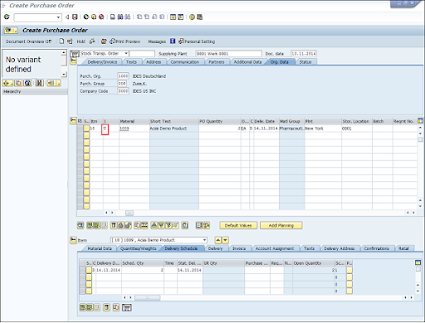ITEM CATEGORY
ITEMS category is show that which type of procurement is done in this purchase order.
Generally , Items Categories are the following types.
1. STANDARD
Items of the category Standard are goods that are to be procured externally. In this case, both goods and invoice receipts are possible.
Characteristics
|
2. LIMIT (B)
Limit items occur in connection with blanket purchase orders (which hence may also be referred to as "P o s with limits or "limit orders"). Blanket P o s can be used to procure a variety of materials or services up to a certain predefined maximum value (the value limit) from a vendor. The nature of the materials or services in question is generally such that the cost of and administrative effort involved in processing individual purchase orders is regarded as disproportionately high in relation to their value (e.g. purchase of office supplies and minor services required during the course of the year).
Blanket PO have the document type FO. Instead of a specific delivery date, you can specify a validity period for the order.
Goods receipts or the entry and acceptance of services performed are not necessary in the case of a blanket PO and limit items. The invoices are posted directly with reference to the purchase order, provided that the specified value limit is not exceeded. The account assignment need only be specified at the time of invoice entry.
Characteristics
|
3. CONSIGNMENT (K)
Items of the category Consignment are items procured on a consignment basis. Account assignments cannot be made for material ordered on consignment. Consignment stocks are managed separately and are not valuated.
Consignment stocks are discussed in the consignment section of the MM Inventory Management documentation.
Characteristics
|
4. SUBCONTRACTING (L)
Order items of the category Subcontracting may represent finished assemblies ordered from a subcontractor, for example. Any components the subcontractor requires from you to produce such an assembly are entered as "material to be provided items.
Subcontracting is discussed in the Subcontracting section of the MM Inventory Management documentation.
Characteristics
|

5. THIRD-PARTY (S)
Third-party orders are orders placed with vendors as part of a triangular business deal, instructing the latter to supply goods to or perform a service for a third party (for example, a drop-shipment to one of your customers). This means that the goods recipient is in this case the customer. "Third-party can be specified in the item category field of a requisition or purchase order.
The third-party order is one of the special order types in Purchasing, and is discussed in the section Third-Party Processing of the MM Inventory Management documentation.
Characteristics
|
6. STOCK TRANSFER (U)
Stock transfer items occur in connection with stock transport ordering. Stock transport orders are a mechanism for the transfer of stock from one plant to another (that is, transfers involving transport over a longer distance).
Characteristics
|

7. SERVICE (D)
Planned services or services whose nature and scope is defined at the time of procurement (Item category D)
In service, a third party provides services to a company. These services include maintenance functions such as electricity and oiling of machines. Follow the steps given below to create a service purchase order.
ACCOUNT ASSIGNMENT CATEGORY
ACCOUNT ASSIGNMENT category shows that which account will be charged for this PO after a good receipt.
It indicates what type of purchase the company is doing in Purchasing Documents, whether it is for consumption or anything relation to orders, projects etc. The nature of this also indicates which accounts it needs to be charged for when the incoming invoice and Goods Receipt are posted.
Description | Required account assignment data |
Asset (A) | Main asset number and sub-number |
Order | Order and G/L account number |
Production order | Production order number |
Business process | Business process and G/L account number |
Cost center (K) | Cost center and G/L account number |
Sales order (C) | Sales order and G/L account number |
Individual customer requirement | Sales order and G/L account number |
Project (P) | Project and G/L account number |
Unknown (U) | None |















































